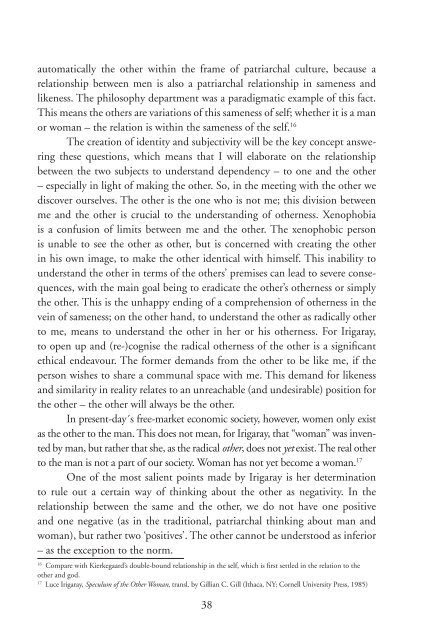Teaching Subjectivity. Travelling Selves for Feminist ... - MailChimp
Teaching Subjectivity. Travelling Selves for Feminist ... - MailChimp
Teaching Subjectivity. Travelling Selves for Feminist ... - MailChimp
You also want an ePaper? Increase the reach of your titles
YUMPU automatically turns print PDFs into web optimized ePapers that Google loves.
automatically the other within the frame of patriarchal culture, because a<br />
relationship between men is also a patriarchal relationship in sameness and<br />
likeness. The philosophy department was a paradigmatic example of this fact.<br />
This means the others are variations of this sameness of self; whether it is a man<br />
or woman – the relation is within the sameness of the self. 16<br />
The creation of identity and subjectivity will be the key concept answering<br />
these questions, which means that I will elaborate on the relationship<br />
between the two subjects to understand dependency – to one and the other<br />
– especially in light of making the other. So, in the meeting with the other we<br />
discover ourselves. The other is the one who is not me; this division between<br />
me and the other is crucial to the understanding of otherness. Xenophobia<br />
is a confusion of limits between me and the other. The xenophobic person<br />
is un able to see the other as other, but is concerned with creating the other<br />
in his own image, to make the other identical with himself. This inability to<br />
understand the other in terms of the others’ premises can lead to severe consequences,<br />
with the main goal being to eradicate the other’s otherness or simply<br />
the other. This is the unhappy ending of a comprehension of otherness in the<br />
vein of sameness; on the other hand, to understand the other as radically other<br />
to me, means to understand the other in her or his otherness. For Irigaray,<br />
to open up and (re-)cognise the radical otherness of the other is a significant<br />
ethical endeavour. The <strong>for</strong>mer demands from the other to be like me, if the<br />
person wishes to share a communal space with me. This demand <strong>for</strong> likeness<br />
and similarity in reality relates to an unreachable (and undesirable) position <strong>for</strong><br />
the other – the other will always be the other.<br />
In present-day´s free-market economic society, however, women only exist<br />
as the other to the man. This does not mean, <strong>for</strong> Irigaray, that “woman” was invented<br />
by man, but rather that she, as the radical other, does not yet exist. The real other<br />
to the man is not a part of our society. Woman has not yet become a woman. 17<br />
One of the most salient points made by Irigaray is her determination<br />
to rule out a certain way of thinking about the other as negativity. In the<br />
relationship between the same and the other, we do not have one positive<br />
and one negative (as in the traditional, patriarchal thinking about man and<br />
woman), but rather two ‘positives’. The other cannot be understood as inferior<br />
– as the exception to the norm.<br />
16<br />
Compare with Kierkegaard’s double-bound relationship in the self, which is first settled in the relation to the<br />
other and god.<br />
17<br />
Luce Irigaray, Speculum of the Other Woman, transl. by Gillian C. Gill (Ithaca, NY: Cornell University Press, 1985)<br />
38

















